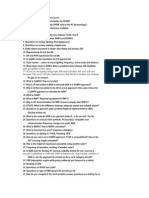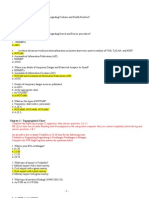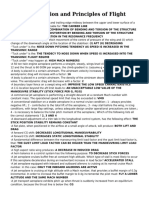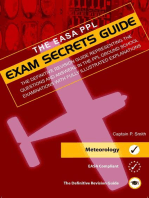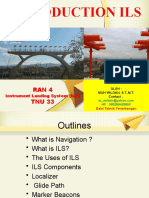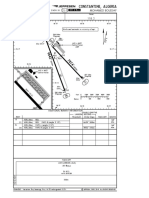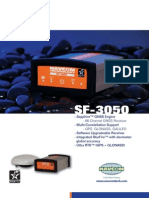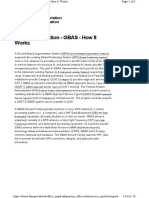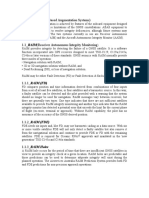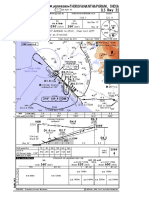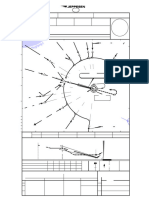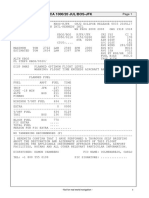ATPL Viva Questions........
ATPL Viva Questions........
Uploaded by
Saurabh GuptaCopyright:
Available Formats
ATPL Viva Questions........
ATPL Viva Questions........
Uploaded by
Saurabh GuptaCopyright
Available Formats
Share this document
Did you find this document useful?
Is this content inappropriate?
Copyright:
Available Formats
ATPL Viva Questions........
ATPL Viva Questions........
Uploaded by
Saurabh GuptaCopyright:
Available Formats
NAV n Radio both 1. Diff between GPWS n EGPWS. KInd of warning EGPWS gives, how does it work 2.
RNP, what exactly is that, RNP 1 better or RNP 10 3. GRID MORA on jepp chart 4. CANPA-Constant angle non precision approach 5. VOR, DVOR(Doppler VOR), NDB, which one would you prefer to use and why 6. RADIO ALT 7. RVSM contingencies 8. ALL types of projections, if you are at equator which type of chart would you use(projection type) 9. What are ILS components 10. Gyro 11. What airspaces are there in India? 12. How many satellites are required for RAIM? 13. Diff b/w ILS X & ILS Y 14. Instruments VOR, NDB, DME, INS, IRS, GPS, Working of a Servo Altimeter, TCAS 15. ILS reference point 16. degrees of freedom is plane of freedom 17. TCAS TA,RA range - Forward Range for TCAS 2 = 40 Nm 18. Speed to be maintained in a DME arc = 230 KIAS 19. TODA and TORA / Clearway and stopway 20. Can you do ILS approach without Glideslope? Ans.-Yes 21. What is the required instrumentation for RVSM? 22. If a pilot is unable to maintain RVSM, what is the RT phraseology? 23. What is ETOPS, Different extensions available 24. Questions on runway lighting (from jeppesons) 25. Questions on runway marking (Jeppesons) 26. Radio failure procedure in Radar, Non-Radar and during a SID 27. Requirements for ILS Cat IIIb? What DH and RVR requirement for cat IIIb 28. Is middle marker mandatory for ILS approaches NO 29. -Marker Locators(NDB co-located with the fan markers) 30. Outer marker colour of visual lighting, frequency, morse code and distance 31. Wind shear mode in GPWS. What is predictive wind shear 32. If you are navigating using triple INS and if all three fail, how will you navigate. GPS 33. What is CANPA? How is it useful? 34. Why is 50 feet added to MDA to calculate DDH in a CANPA approach? 35. Why is 50 feet not added to the DH in an ILS approach if the same if done for a CANPA approach to calculate the DDH? (ILS more accurate and inline with r/w center line) 36. What is FANS? 37. What is RNP? Required equipment for RNP-521.Why is the instrumentation for RNP-10 more complex than RNP-5?
38. ETOPS: What is the difference between adequate airport and suitable airport? 39. What is MORA? How is MORA calculated? 40. What is mountainous area? 41. Questions on lighting in TVASI, Pulsating VASI 42. ILS error 43. How do you carry out a CANPA approach if FAF is not published? How is theFAF crossing height calculated? 44. How is the height of cloud base calculated using weather radar? 45. Frequency of operation, working of weather radar? 46. In NDB chart for Runway 07 chennai, visibility minima for cat c and cat d aircraft is published as 3400 and 5000 m respectively. If prevailing visibility is3400 m, can the approach be carried out for a cat b category aircraft? 47. VOR interception angles while going outbound and inbound to a station 48. Working of GPS35.Questions on WAAS and LAAS36.Questions on type of FMS aboard the aircraft you fly 49. How do you navigate to the north pole(the answer examiners are looking for isgrid navigation) 50. In Chennai, what is the direction of the runway slope? (the whole idea is supposedly to check if you are familiar with the aerodrome you operate out of) 51. Why is circle to land operations not allowed south of RWY 27 in Mumbai? 52. If the wavelength is 2 cm, what is the frequency? 53. Primary radar v/s secondary radar. 54. Working of weather radar. 55. How is cloud height calculated using weather radar? 56. Frequency band of SHF. 57. What is a BFO? 58. Construction of various Instrument like ASI, IVSI, Mack Meter, etc 59. Fail Passive and Fail Operational App. 60. Difference between tcas i and tcas ii. What type is on youre a/c. also what version of TCAS used TCAS 7.0? 61. What is TAU in terms of TCAS (The estimated time in wich a intruder aircraft becomes a thread is called TAU. There is a different TAU value for TA as there is for RA because the RA range is smaller) Tau TCAS primarily uses time-to-go to CPA rather than distance to determine when a TA or an RA should be issued. The time to CPA is called the range tau and the time to co-altitude is called the vertical tau. Tau is an approximation of the time, in seconds, to CPA or to the aircraft being at the same altitude. CPA (Closest Point of Approach) 62. What is TAWS, FANS? 63. They ask me on B777 where is the EGT sensor located. As in have u ever physically seen it ???? of course they were Airbus guys asking wrong question!!! 64. How does GPS give positions information? 65. Difference between Predicted Wind shear (PWS) and Reactive Wind shear which one is given by weather radar and which one by EGPWS?
66.
Future Air Navigation System The Future Air Navigation System (FANS) is an avionics system which provides direct data link communication between the pilot and the Air Traffic Controller. The communications include air traffic control clearances, pilot requests and position reporting FANS-1 and 2 by Boieing FANS-A and B by Airbus FANS-1/A common
The ILS Has Five Components
Part 1 the Localizer The localizer at departure end of runway provides lateral references. Frequencies are 108.l by odd tenths to 111.9. It is identified by "I" (..) as first of four letters. Fan width varies from 3 to 6 degrees and may not be aligned with the runway. It is useable within 35 degrees of course. An LDAs range of tolerance is identical to that of the ILSs but is more likely to be in the 6 degree range. It is 4 times more sensitive than VORs. One degree of localizer fan sensitivity is only 25' at one mile. Back course should not be used for navigation unless authorized. An ADF (simplified directional facility) is fixed at either 6 or 12 degrees, whichever is best at the site. Part 2 the Glide Slope The glide slope is abeam 1000' marker of runway and provides threshold crossing height (TCH). It is not useable if crossing threshold below 50'. The course width of the glide slope is 1.4 degrees. Useable course distance is 10 nautical miles. On the glide slope approach will give a touchdown at 1000' markers. UHF frequencies at 330 paired with localizer. Same angle as VASI. The reason for a glide slope interception altitude is because of higher "false slopes". May have DME but more often not. (see Reno). No levelling off at decision height (DH). Reverse sensing on back course standard VOR but not on HSI. The glide slope angle is usually 3 degrees. You can determine the descent rate of the 3 degree slope by using the charts in Jeppesen or a rule of thumb based on your ground speed. The thumb rule is good for practice. Multiply your ground speed by 5 and add 50. (90 kts x 5 + 50 = 500 (Should be 485) Part 3 Outer marker You cannot fly an ILS if the outer marker is out and no other authorized definition/substitution for the fix exists. AIM 1010 and FAR 91.175(k) The outer marker is five miles from runway. It is the Blue light. Interception of ILS glide slope may be before, at or after OM. ILS final approach fix often is different from localizer only approach. Timing of localizer approach is always from OM as the non-precision FAF. Put this altitude into your need to know approach checklist. ILS Outer Marker (OM) is fan-shaped across ILS localizer course about 4 1/2 miles from approach end of runway. In the United States, the outer marker has often been combined with an NDB to make a Locator Outer Marker (LOM). Some ILS approaches have no navigation aid at all situated at the final approach fix, but use other means, such as VOR radial intersections, distance measuring equipment (DME), GPS, or radar fixes, to identify the position. Part 4 the Middle marker (amber) A point on the ILS glide slope Final altimeter check. MM should be part of briefing. The middle marker is 1/2 (3500 feet) mile from runway at decision height which is typically 200' AGL above TDZ. MM inoperative does not change minimums as of 1993. Check the marker crossing altitude as an altimeter check. The middle marker is not a required component for full ILS minimums nor the localizer. The Inner Marker (IM) is fan shaped across ILS localizer course about 1/2 mile from approach end of runway. On a back-course the marker, if used, is white. The traditional inner marker is becoming obsolete. Removal of the inner marker does not affect minimums. Up until the 1970s there were still LF/MF four course radio ranges in use known as radio range, Adcock range, standard radio range, A/N range and L/MF range. The range uses a 200-425 kilocycle (Hertz) signal to provide course guidance through the ADF. These ranges are still in use worldwide. Older aircraft will have an "Airway Marker Beacon" light along with Outer and Inner marker lights which transmit on 75 megacycles (Hertz) to provide definite position information. Marker Beacons
Fan Marker: 100 watts power with 3000 cps (cycle per second) tone emitted in a fan shape three miles wide and 12 miles across an airway. Dumbbell Marker Same as fan marker but narrow middle is only 1-1/2 miles wide. Z Marker (Station Locator Marker) Located at radio range site and identifies centre of range. (cone of silence). Part 5 Approach Lighting System (ALS) (See AIM for variations) MALSR and SSALR have runway alignment lights (R means runway) MALS and SSALS do NOT have runway alignment lights Approach Lights Approach lights define the runway threshold. With approach lights an NDB can have minimums of 3/4-mile with 250 height above touchdown (HAT). Approach lights do not affect DA or MDA just visibility. Any loss of approach lighting will increase visibility minimums from 1/4 to 1/2-mile. (ODALS) Omni-directional approach light system gives 1/4 mile credit. (MALS) Medium intensity approach light system of 1400 likewise. (SALS) Simplified approach light system 1200+ light-bar likewise. (SSALR/MASR) Simplified short approach light system, sequenced flashing lights and medium approach light system from 1400 to 2400 NDB gets 1/4 mile credit while other non-precision get 1/2 mile. (ALSF-1) Highest standard of non-precision approach lighting with sequenced flashers (the rabbit) extending to 3000 gives 1/2-mile credit. Has red termination bar. 5-levels of brightness. RAILS (ALSF-1) Like ALSF-1 but has red side row bars and low/high modes.
You might also like
- SkyTest® Airline Interview - The Exercise Book: Interview questions and tasks from real life selection procedures for pilots and ATCOsFrom EverandSkyTest® Airline Interview - The Exercise Book: Interview questions and tasks from real life selection procedures for pilots and ATCOsRating: 4 out of 5 stars4/5 (14)
- AircraftPerformance Keith Williams PDFDocument440 pagesAircraftPerformance Keith Williams PDFmumsum83% (18)
- Atpl Viva Questions UpdatedDocument9 pagesAtpl Viva Questions UpdatedMegha UdayshankarNo ratings yet
- Altimeter Practice Question1Document4 pagesAltimeter Practice Question1Rohit100% (1)
- PPL Exam Secrets Guide - Aviation Law & Operational ProceduresFrom EverandPPL Exam Secrets Guide - Aviation Law & Operational ProceduresRating: 4.5 out of 5 stars4.5/5 (3)
- SESADocument22 pagesSESAMosquera Alex100% (1)
- ATPL OralDocument4 pagesATPL OralHarjeevChawla100% (1)
- NAV N Radio VivaDocument36 pagesNAV N Radio VivaMegha Udayshankar100% (1)
- ATPLViva QuestionsDocument27 pagesATPLViva QuestionscaptravipooniaNo ratings yet
- ATPL Sample Questions - Radio AidsDocument5 pagesATPL Sample Questions - Radio AidsAbhinaya Sekar100% (2)
- RTRDocument241 pagesRTRTRUE strive ltd100% (1)
- RT Calls PDFDocument208 pagesRT Calls PDFZUFINE Kht100% (2)
- QDB 15 Radio NavDocument83 pagesQDB 15 Radio NavKueh Chew Chai100% (13)
- Aviation Study Material - Sample Questions For RTR (A) Part 1 ExamDocument6 pagesAviation Study Material - Sample Questions For RTR (A) Part 1 ExamRajesh67% (3)
- General NavigationDocument162 pagesGeneral Navigationredbeard_0650% (2)
- CP & PNRDocument4 pagesCP & PNRvinay100% (1)
- SAEZ - ChartsDocument14 pagesSAEZ - ChartsThe Priest100% (2)
- CGKDocument58 pagesCGKGenesis AeroNo ratings yet
- Atpl Oral QBDocument3 pagesAtpl Oral QBNikhilesh 'gamble' IngaleNo ratings yet
- Atpl Viva QuestionsDocument2 pagesAtpl Viva Questionsgigablade7425% (4)
- ATPL Oral NotesDocument8 pagesATPL Oral NotesTanishq VashisthNo ratings yet
- NAV N Radio ATPL Viva With AnswersDocument31 pagesNAV N Radio ATPL Viva With AnswersnodynarenNo ratings yet
- Atpl OralDocument4 pagesAtpl OralAjay KoikalNo ratings yet
- Nav VivaDocument6 pagesNav Vivasupandeepsingh9394100% (1)
- ATPL VivaDocument71 pagesATPL Vivacarltonfenandes100% (1)
- Jet Airways Trainee First Officer 2010 ExamDocument12 pagesJet Airways Trainee First Officer 2010 ExamCyril Mathew RoyNo ratings yet
- Atpl QuestionsDocument2 pagesAtpl QuestionsNiteshNo ratings yet
- Indio Interview Preparatory ClassesDocument2 pagesIndio Interview Preparatory ClassesSabari SasichandranNo ratings yet
- ICAviation (Part-2) QuestionnaireDocument1 pageICAviation (Part-2) QuestionnaireGaurav SawaaiNo ratings yet
- RadioNavigation QB 1Document64 pagesRadioNavigation QB 1Vishwadeep Barge100% (2)
- Volume 7 - Flight PlanningDocument55 pagesVolume 7 - Flight PlanningBui Duc Hai100% (7)
- RTR Terms and DefinitionsDocument19 pagesRTR Terms and DefinitionsJhony BhatNo ratings yet
- RTR Reference NotesDocument31 pagesRTR Reference NotesViral Bhatt100% (5)
- GSP Gen NavDocument179 pagesGSP Gen Navbhartisingh0812100% (1)
- TechnicalDocument100 pagesTechnicalTushar MantriNo ratings yet
- EASA Flight RulesDocument5 pagesEASA Flight Rulesjoethompson007No ratings yet
- Qs in Interview of RTR (A)Document3 pagesQs in Interview of RTR (A)Crystal Murray100% (3)
- Qs in Interview of RTR ADocument3 pagesQs in Interview of RTR ANirja oza100% (1)
- RTR (A) - Questions - Consolidated PDFDocument119 pagesRTR (A) - Questions - Consolidated PDFSriram SNo ratings yet
- Metrology PDFDocument17 pagesMetrology PDFrahulNo ratings yet
- ATPL Oral 2019 Students 97 - 3 2019Document86 pagesATPL Oral 2019 Students 97 - 3 2019Omshree Patel100% (1)
- Sample Question Bank: Frto ExamDocument6 pagesSample Question Bank: Frto ExamDIP100% (1)
- Qs in Interview of RTR ADocument3 pagesQs in Interview of RTR AAishaNo ratings yet
- ATPL VIVA (Capt. Suraj)Document114 pagesATPL VIVA (Capt. Suraj)nisthaa.arora05No ratings yet
- Radio Navigation and Principles of FlightDocument49 pagesRadio Navigation and Principles of FlightMahesh Mahajan100% (1)
- B. Agonic Line: Examination QuestionsDocument7 pagesB. Agonic Line: Examination QuestionsGerry RumahorboNo ratings yet
- ATPL Trainer Summary ALAWDocument24 pagesATPL Trainer Summary ALAWM100% (1)
- Met Atpl QDocument6 pagesMet Atpl QBharat Harmilapi100% (1)
- QDB 15 Ifr & VFRDocument14 pagesQDB 15 Ifr & VFRKueh Chew Chai100% (4)
- Nav VivaDocument6 pagesNav VivaprachatNo ratings yet
- GSP Vol IV METDocument267 pagesGSP Vol IV METSojin Soman100% (2)
- Met Q OxfordDocument158 pagesMet Q OxfordEagle NavNo ratings yet
- Radio Navigation QuestionsDocument11 pagesRadio Navigation Questionsgregm100% (1)
- RTR Part 2 Questions.Document6 pagesRTR Part 2 Questions.Shihabudheen Parakkal63% (8)
- RTR Test 02Document1 pageRTR Test 02pushpak kumar Jha0% (1)
- Cop-Rtr Calls 2013Document119 pagesCop-Rtr Calls 2013Pria Vanjul50% (6)
- V.L.Singh'S RTR (A) Private TutorialsDocument13 pagesV.L.Singh'S RTR (A) Private Tutorialsvinay100% (1)
- Instrument Rating QuestionsDocument88 pagesInstrument Rating Questionskhushal bansal100% (1)
- GPS Seminar PaperDocument10 pagesGPS Seminar PaperChethan Kumar RENo ratings yet
- IAP Charts (FIR - VI)Document41 pagesIAP Charts (FIR - VI)sunil kumarNo ratings yet
- Rctp/Tpe Taipei, Taiwan: Star Overview All Rwys (East)Document69 pagesRctp/Tpe Taipei, Taiwan: Star Overview All Rwys (East)Bob JohnNo ratings yet
- Introduction ILSDocument38 pagesIntroduction ILSFajar IrawanNo ratings yet
- Chapter 13 DMEDocument48 pagesChapter 13 DMEneviaNo ratings yet
- PrintDocument7 pagesPrintKarim ZidaneNo ratings yet
- Jeppview 3.6.3.1: Licensed To Nanang S. Printed On 02 Sep 2009Document8 pagesJeppview 3.6.3.1: Licensed To Nanang S. Printed On 02 Sep 2009Anonymous ok8K8qeW4zNo ratings yet
- Sbbi - NDB B Rwy 18 36 - Iac - 20211104Document1 pageSbbi - NDB B Rwy 18 36 - Iac - 20211104Fábio KastelamaryNo ratings yet
- SF-3050 DS 5-27-09 Low-ResDocument2 pagesSF-3050 DS 5-27-09 Low-ResTsukasa OgiharaNo ratings yet
- GBAS - How It WorksDocument4 pagesGBAS - How It WorksPhong TranNo ratings yet
- Hyperbolic Navigation Systems QuestionsDocument12 pagesHyperbolic Navigation Systems QuestionsjaguerjaquezNo ratings yet
- Annex 3 - Computation Procedure Rinex - v32Document6 pagesAnnex 3 - Computation Procedure Rinex - v32Edgar DomínguezNo ratings yet
- ABAS (Aircraft Based Augmentation Systems) : 1.1 - RAIM (Receiver Autonomous Integrity MonitoringDocument7 pagesABAS (Aircraft Based Augmentation Systems) : 1.1 - RAIM (Receiver Autonomous Integrity MonitoringJoy LingNo ratings yet
- (5b) LAB - GNSSDocument12 pages(5b) LAB - GNSSfasahatxNo ratings yet
- WVR 7012/20 MAY/GRU-IGU: - Not For Real World NavigationDocument32 pagesWVR 7012/20 MAY/GRU-IGU: - Not For Real World NavigationFrancisco FortesNo ratings yet
- Thiruvananthapuram, India Votv/Trv ILS Rwy 32: D2.7 D6.2 115.1 TVMDocument1 pageThiruvananthapuram, India Votv/Trv ILS Rwy 32: D2.7 D6.2 115.1 TVMayanmnnitNo ratings yet
- Lsggfimp PDF 1535226543Document76 pagesLsggfimp PDF 1535226543Bertrand ClxNo ratings yet
- Non Directional BeaconDocument9 pagesNon Directional BeaconGivaldoNo ratings yet
- Ils W 15 SBCTDocument1 pageIls W 15 SBCTgameplayPSNo ratings yet
- App MMMD Ils Loc y Rwy 10Document1 pageApp MMMD Ils Loc y Rwy 10ÁNGEL 123No ratings yet
- GPS-20A MKDocument2 pagesGPS-20A MKZinmin BaboNo ratings yet
- PPLS Seri A Februari 2020 PDFDocument33 pagesPPLS Seri A Februari 2020 PDFhedriansyah edNo ratings yet
- Kbos KJFKDocument24 pagesKbos KJFKCarlitosIbanezNo ratings yet
- Notams MUCDocument2 pagesNotams MUCOmar HilalNo ratings yet
- YPKGDocument11 pagesYPKGjoker hotNo ratings yet
- Anti Spoofing and Selective AvailabilityDocument2 pagesAnti Spoofing and Selective Availabilityanjali9myneniNo ratings yet
- NIgerian Jeppesen Charts DNXXDocument110 pagesNIgerian Jeppesen Charts DNXXADEJUMO ADEBUSOYE ADEYEMINo ratings yet




















